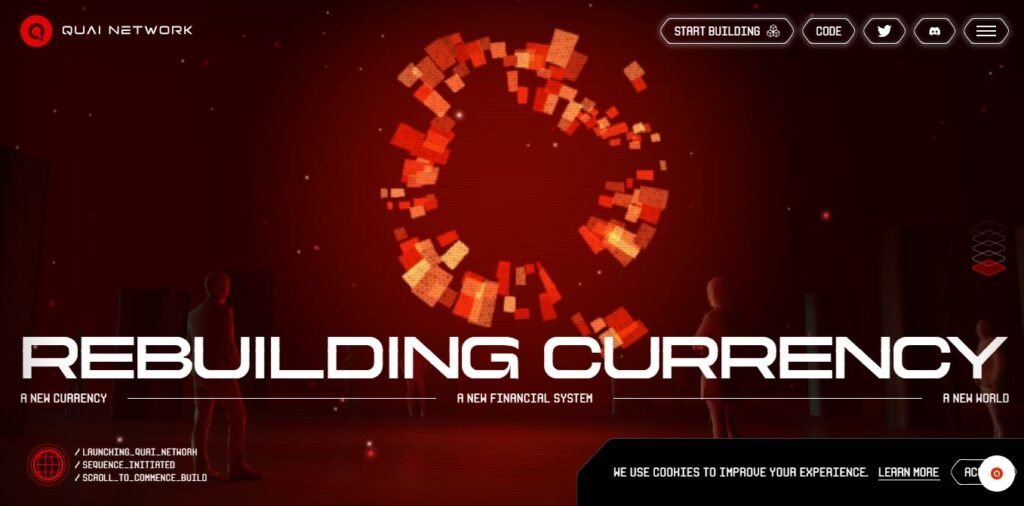Quai Network (QUAI): The #1 Energy-Backed Blockchain of 2025
As blockchain adoption accelerates across industries, the demand for scalable, efficient, and decentralized solutions has never been greater. Legacy networks like Bitcoin and Ethereum have laid the groundwork for decentralized finance and smart contracts, but they often struggle with high fees, congestion, and energy inefficiency. The crypto landscape of 2025 is shifting, and new contenders are emerging to tackle these long-standing limitations.
Quai Network has entered the arena as a groundbreaking Layer 1 blockchain aiming to redefine what’s possible with Proof-of-Work. Unlike traditional networks, Quai Network introduces an innovative consensus model—Proof-of-Entropy-Minima—which eliminates block contention and delivers lightning-fast transaction finality. This technical advancement alone would make it noteworthy, but Quai goes a step further by integrating a unique, energy-based currency model through its “flatcoin,” known as Qi.

In a time when inflation-resistant and energy-aware monetary systems are gaining attention, Quai Network stands out by aligning the value of its native currency with real-world energy costs. This bold approach positions Quai not just as another blockchain, but as a future-ready monetary infrastructure built for the compute economy.
Table of Contents
2. The Technology Behind Quai Network
Proof-of-Entropy-Minima: Next-Gen Proof-of-Work
At the core of Quai Network lies a revolutionary consensus mechanism called Proof-of-Entropy-Minima (PoEM)—a next-generation evolution of traditional Proof-of-Work (PoW). While conventional PoW systems like Bitcoin rely on raw computational power to solve cryptographic puzzles, leading to energy inefficiency and slow confirmation times, Quai Network’s PoEM mechanism introduces a smarter, more efficient approach.
Instead of competing on who can produce the next block first, PoEM selects the block that minimizes entropy—a measure of randomness in a decentralized system. This method drastically reduces block contention, meaning that miners no longer waste resources competing over the same block. As a result, Quai Network achieves near-instant transaction finality, even in a decentralized, permissionless environment.
By eliminating the bottlenecks and redundancies of traditional mining, Quai Network not only conserves energy but also enhances network efficiency and responsiveness—two essential qualities for any blockchain aiming for real-world adoption.
Multi-Chain Architecture for Scalability
Scalability remains one of the biggest challenges in blockchain development, and Quai Network tackles this head-on with a modular multi-chain architecture. Instead of relying on a single monolithic chain, Quai operates as a network of interconnected blockchains that run in parallel, each responsible for a portion of the network’s workload.
This structure enables horizontal scalability, allowing the network to process thousands of transactions per second without sacrificing decentralization or security. Each chain in the Quai Network communicates seamlessly, ensuring data consistency and interoperability while maintaining the integrity of the entire system.
Because of this design, Quai Network can grow organically with demand, supporting more users, applications, and data without congestion or high gas fees. It’s an elegant and forward-thinking solution for the next wave of blockchain use cases—from DeFi and gaming to cross-border payments and the compute economy.
3. Qi Flatcoin: Energy-Backed Decentralized Money
What Is Qi?
Qi is the native flatcoin introduced by Quai Network, designed to function as decentralized, energy-pegged money for the digital and compute economy. Unlike traditional cryptocurrencies that fluctuate wildly in value or stablecoins that are pegged to fiat currencies, Qi offers a unique middle ground—a currency that maintains purchasing power by aligning its value with the cost of energy, the most fundamental input of computation.
- Flatcoin Defined: A flatcoin is a type of cryptocurrency that remains “flat” or stable in real value, not by tracking fiat like USD, but by maintaining purchasing power over time, often pegged to more objective, tangible metrics like energy.
- Qi vs. Stablecoins: While stablecoins like USDT or USDC are pegged to centralized assets like the U.S. dollar and subject to traditional monetary policies, Qi operates independently of centralized banking systems. It offers stability without fiat dependence, making it ideal for truly decentralized economies.
- Decentralized by Design: Qi is not controlled by a central issuer or governed by off-chain reserves. Its value is determined algorithmically based on energy inputs, reinforcing Quai Network’s goal of building trustless, transparent, and censorship-resistant financial infrastructure.
Pegged to Energy: The Compute Economy Explained
Quai Network introduces a forward-thinking economic model that ties digital money to the real-world cost of energy—the foundational resource behind all computing power. This approach makes Qi a more resilient and economically grounded form of currency.
- Energy as a Value Standard: Qi derives its value from the cost of producing entropy (computational randomness) in the Quai Network. This means that as the cost of energy fluctuates, so does the minting cost of Qi, allowing it to maintain relative purchasing power within a compute-driven economy.
- Resisting Inflation: Unlike fiat currencies, which lose value over time due to inflation and monetary expansion, Qi resists devaluation by linking its issuance to a scarce and essential resource: electricity.
- Real-World Use Cases: Qi is designed for utility in the compute economy, where applications require decentralized, scalable, and energy-aligned payment methods. This includes:
- Decentralized cloud computing
- High-performance data processing
- Machine learning marketplaces
- Cross-border energy-based remittances
4. Tokenomics: Understanding QUAI
Supply Overview
To fully grasp the potential of Quai Network, it’s essential to understand the tokenomics of its native token, QUAI. Like any cryptocurrency, QUAI’s supply dynamics play a significant role in its valuation, inflation rate, and long-term sustainability.
- Total vs. Circulating Supply: As of May 2025, the total supply of QUAI is reported at 3 billion tokens, with a self-reported circulating supply of 478 million QUAI. This means only a fraction of the total token supply is currently available for trading, potentially limiting sell pressure and increasing scarcity in early stages.
- No Max Supply: What It Means: Unlike Bitcoin’s hard cap of 21 million, QUAI has no predefined maximum supply. Instead, its issuance is tied to the energy-driven Proof-of-Entropy-Minima model, aligning new token creation with real-world computational cost. This makes QUAI a more elastic monetary unit, where supply expansion is dictated by network growth and utility rather than arbitrary limits.
This flexible model allows Quai Network to dynamically scale its monetary base while still maintaining purchasing power through its flatcoin, Qi. It’s a long-term strategy meant to support a growing decentralized economy without excessive deflation or runaway inflation.
Market Stats (As of May 2025)
Here are the most recent metrics reflecting QUAI’s market performance, based on data from CoinMarketCap and self-reported figures:
- Market Capitalization: $45.72 million
- 24-Hour Trading Volume: $2 million
- Fully Diluted Valuation (FDV): $286.42 million
- Volume/Market Cap Ratio: 4.38%
These stats indicate a high level of liquidity relative to its market cap, which suggests growing trader interest and active participation. The wide gap between market cap and FDV also highlights the impact of the low circulating supply—a key consideration for potential investors or participants in the Quai Network ecosystem.
Self-Reported Metrics: Why It Matters
Quai Network currently provides self-reported supply data, meaning the circulating supply hasn’t yet been verified by third-party data aggregators or automated tracking systems. While this is common for new or early-stage blockchains, it’s important for users and investors to:
- Monitor updates from official sources
- Verify on-chain data when possible
- Stay informed as the network undergoes audits or listings on more exchanges
That said, Quai Network’s transparent communication and consistent reporting help build trust, and over time, more verifiable metrics are expected as it gains traction across exchanges and blockchain analytics platforms.
5. Use Cases and Ecosystem Potential
Real-World Applications
Quai Network is more than just a technological innovation—it’s built with real-world utility at its core. The network is designed to support a broad range of applications, particularly in sectors that demand speed, decentralization, and economic stability.
- Global Digital Money: With its Qi flatcoin, Quai Network provides a decentralized alternative to traditional fiat and stablecoins, ideal for cross-border payments and everyday transactions.
- Remittances: Thanks to near-instant finality and low transaction friction, Quai can serve as a cost-effective solution for global remittances, allowing users to send money across borders without reliance on banks or centralized processors.
- Compute Economy: Quai’s energy-aligned economic model is ideal for powering the decentralized compute economy—from AI marketplaces to distributed data processing platforms. Qi’s energy peg ensures that computational resources are fairly valued and compensated.
- DeFi and DApps: With scalable infrastructure and a developer-friendly architecture, DeFi projects, NFT platforms, and decentralized applications can run efficiently on Quai without the limitations of congestion or high gas fees.
Developer and Community Focus
For any Layer 1 blockchain to thrive, it needs a vibrant ecosystem—and Quai Network is actively cultivating one.
- Ecosystem Incentives: Quai has launched initiatives to incentivize developers and early adopters, including grant programs, hackathons, and token-based rewards. These efforts aim to bootstrap innovation and ensure the network grows with meaningful, real-world use cases.
- Developer Onboarding: Quai Network offers toolkits, APIs, and documentation to make building on the platform easy and intuitive. Its modular architecture simplifies deployment and scaling, enabling developers to build highly performant decentralized apps.
- Community Engagement: With growing social channels and a transparent development roadmap, Quai is fostering a strong, community-led governance model, encouraging participation and feedback from users and builders alike.
6. Quai Network vs. Other Layer 1 Blockchains
Comparisons with Ethereum, Solana, and Kaspa
As a next-gen Layer 1 blockchain, Quai Network competes with some of the biggest names in the space, but it distinguishes itself through several key technical and economic advantages:
| Feature | Ethereum | Solana | Kaspa | Quai Network |
| Consensus Mechanism | Proof-of-Stake | Proof-of-History | BlockDAG PoW | Proof-of-Entropy-Minima |
| Scalability | Moderate | High (w/ risk) | High | High (modular multi-chain) |
| Finality Speed | ~13 sec | ~400ms | Fast | Near-instant |
| Decentralization | Moderate | Lower | High | High |
| Energy Efficiency | High (PoS) | Moderate | Lower | Aligned with energy cost |
| Use of Resources | Variable | High | High | Efficient + resource-aware |
Unique Value Proposition
What truly sets Quai Network apart is its energy-based economic model, modular scalability, and a novel PoW system that eliminates redundancy. These combined elements give Quai a strategic edge:
- Energy-Pegged Currency (Qi): Aligns economic incentives with real-world resources, ensuring sustainable value.
- Entropy-Based Consensus: Prevents waste and enhances network efficiency.
- Multi-Chain Architecture: Allows for near-infinite scalability without centralized bottlenecks.
- Developer-First Approach: Simplifies building, attracts talent, and accelerates ecosystem growth.
7. Future Outlook: Is Quai Network the Next Big Blockchain?
Growth Potential and Adoption
Quai Network shows strong potential for growth in 2025 and beyond. Its innovative Proof-of-Entropy-Minima consensus combined with an energy-pegged flatcoin creates a unique value proposition that addresses both technical and economic challenges faced by current blockchains.
As decentralized applications, DeFi platforms, and the compute economy expand, demand for scalable, energy-efficient, and stable monetary solutions will only increase—areas where Quai is strategically positioned to lead. Early adoption by developers and users, coupled with active ecosystem incentives, could fuel organic network growth and expand real-world use cases.
The project’s self-reported circulating supply and market metrics suggest growing liquidity and investor interest, indicating that the community is paying attention to this new blockchain.
Risks and Challenges
Like any emerging blockchain project, Quai Network faces several risks:
- Adoption Curve: Gaining traction among developers and users is never guaranteed, especially in a competitive space crowded with established players like Ethereum and Solana.
- Regulatory Landscape: Evolving global crypto regulations could impact token utility, market access, or network governance.
- Competition: Numerous Layer 1 blockchains are innovating rapidly. Quai must continue to deliver on its technical promises and ecosystem growth to maintain relevance.
However, Quai’s transparent roadmap, innovative technology, and focused approach to energy economics provide a strong foundation to mitigate these challenges.
Conclusion
Quai Network stands out in 2025 as a top new blockchain project with a fresh take on Proof-of-Work and decentralized money. Its energy-based flatcoin, Qi, addresses key issues of currency stability and sustainability, while its Proof-of-Entropy-Minima consensus and modular multi-chain architecture deliver scalability and speed.
For investors, developers, and crypto enthusiasts looking for the next generation of blockchain innovation, Quai Network offers a compelling combination of technology and economic foresight.
Stay ahead of the curve by following Quai Network’s journey, exploring its ecosystem, and joining a growing community focused on building the future of decentralized energy-backed money.
Read Also : MixieAI & MIXIE Token: 5 Reasons It’s Revolutionizing Web3 Game Creation






